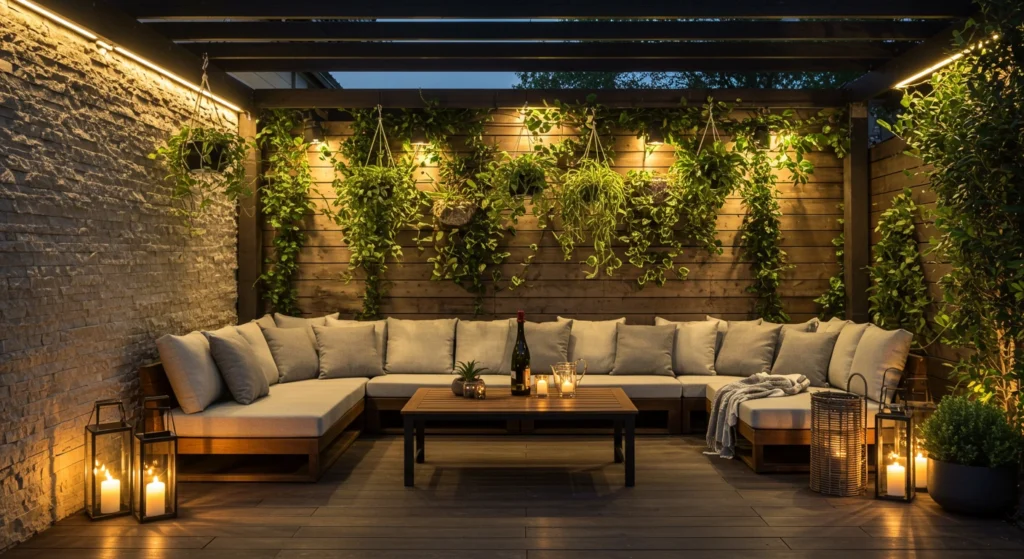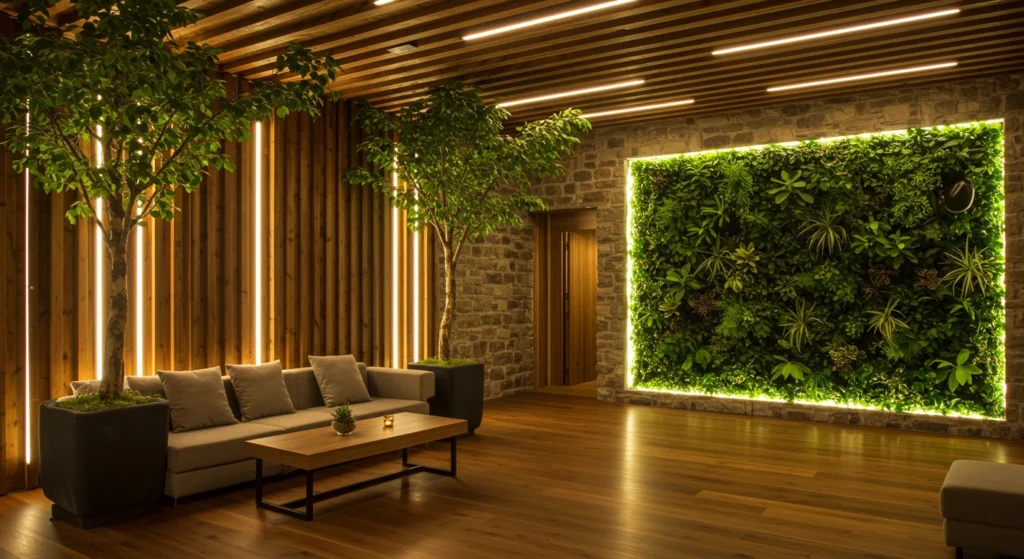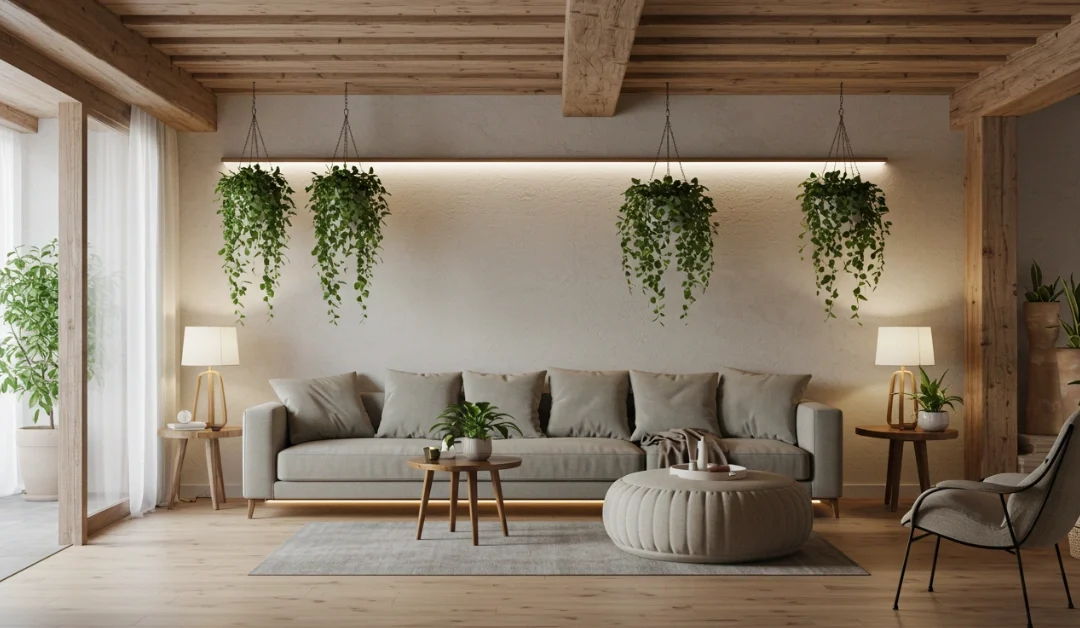Biophilic lighting comes from the concept of biophilic design, which is all about reconnecting people with nature. The word biophilia means “love of nature,” and when applied to design, it refers to creating spaces that make people feel closer to the natural world. In lighting, this means using fixtures, tones, and placements that mimic natural light or bring elements of the outdoors inside.
1. How is Lighting Connected to Nature?
Think about how sunlight filters through trees, changes throughout the day, or reflects off a surface like water. Biophilic lighting uses these same patterns, colors, and movements to bring a natural, calming feel indoors.
For example, soft, dappled light from a rattan pendant or a lamp that casts leaf-shaped shadows on the wall can instantly make a room feel more grounded and alive.
Why Are People Choosing Nature-Inspired Illumination Today?
Most people now spend more than 90% of their time indoors. This disconnect from nature can affect mood, focus, and even physical health. That’s why biophilic lighting is gaining popularity—it helps fill that gap.
Whether it’s using a lamp with a wood base, fixtures made of organic materials, or lights designed to mimic sunrise and sunset, more people are choosing lighting that doesn’t just look good—it feels good.
2. How Do Natural Materials Play a Role in Biophilic Lighting?

The materials used in lighting fixtures make a big difference. Biophilic lighting often features raw, earthy elements—like wood, clay, bamboo, wicker, cork, or even stone. These materials don’t just look natural; they feel natural.
They age beautifully, have unique textures, and bring character to a space. Even metal can be used if it’s finished in a matte, rustic, or hand-forged look.
What Kind of Colors and Textures Mimic Nature Best?
Nature doesn’t do neon or high gloss. Biophilic lighting favors neutral tones—browns, creams, soft greens, sandy beiges, and warm yellows.
Textures should feel tactile: woven fibers, carved wood grains, or uneven surfaces that remind you of bark, leaves, or pebbles. These tones and textures create a sense of calm and connection.
What Makes a Fixture Feel “Organic” Instead of Synthetic?
An organic fixture follows natural curves, not rigid lines. Think of a lamp that spirals like a vine or a light shade shaped like a flower petal. The difference between an “organic” design and a “synthetic” one is subtle but powerful.
It’s in the softness of the shape, the use of imperfections, and the balance of structure and flow—much like how things grow in nature.
3. What Are Plant-Inspired Light Fixtures and How Do They Work?
Plant-inspired light fixtures are designed to echo the shapes, movement, and energy of plants. Some resemble hanging vines or tree branches. Others have shades shaped like leaves, flowers, or seed pods.
Some even integrate real or artificial greenery directly into the fixture. These lights don’t just illuminate a space—they become part of the decor and contribute to a plant-rich environment.
How Can You Use Living Wall Lighting to Enhance Greenery?
Living walls (or vertical gardens) look beautiful, but without the right lighting, they fade into the background. Low-heat LED lights installed above or around a living wall can highlight the colors and textures of the plants while promoting healthy growth. Choose soft spotlights or hidden strip lighting that makes the greenery look lush and inviting, especially in the evenings.
What Are Natural Motif Lamps and Where Do They Fit Best?
Natural motif lamps often use patterns found in the wild—like ferns, feathers, rippling water, or tree rings. These lamps work well in bedrooms, reading corners, or hallways where soft, mood-enhancing light is needed. Because they blend function with visual storytelling, they help create a more immersive and soothing environment.
4. How Can You Incorporate Biophilic Lighting Room by Room?

In the living room, you can use large pendant lights made of rattan, floor lamps with a tree-branch base, or wall sconces that mimic the look of sunlight filtering through leaves.
Biophilic lighting in this space should feel open, warm, and layered—mixing overhead light with smaller lights that cast gentle glows around the room.
How Do You Bring Nature to Your Bedroom Through Lighting?
Bedrooms benefit from calm, low-level biophilic lighting. Lamps with soft linen shades, driftwood bases, or leafy shadows are ideal. Avoid cold white bulbs—stick to warm tones that mimic sunrise or sunset. You can also use backlit headboards with plant motifs or wall lights that reflect gentle, natural shapes.
What About Biophilic Lighting in Kitchens or Bathrooms?
In kitchens, pendant lights over the island or dining table can use wooden frames or glass inspired by water drops. Bathrooms work well with stone or pebble-textured fixtures, especially near mirrors. The key in both rooms is to balance task lighting with warmth so that even functional areas feel relaxed and natural.
5. Are Bamboo, Rattan, or Wood-Based Fixtures Better?
All three are excellent materials for biophilic lighting. Bamboo grows fast, making it sustainable and eco-friendly. Rattan adds texture and a casual, natural look.
Wood, especially reclaimed or unfinished types, brings a grounding feel. These materials blend easily with indoor plants and natural finishes like jute, linen, or clay.
How Do Leaf Patterns, Vines, or Floral Shadows Change the Mood?
Shadows play a big role in how a space feels. When light passes through a fixture designed with natural patterns—like leaves or flowers—it casts soft, irregular shadows.
This mimics what happens outdoors and adds visual depth. These patterns break the monotony of flat walls and create a living, breathing atmosphere.
6. What Do Studies Say About Natural Light and Mood?
Research shows that exposure to natural light supports better sleep, lower stress, and improved focus. While artificial light can strain the eyes and cause headaches, lighting that mimics daylight—especially in rhythm and color—helps regulate mood and boosts energy.
How Can Soft, Warm Illumination Reduce Stress at Home?
Harsh overhead lights make a room feel cold or stressful. On the other hand, warm, dimmable biophilic lighting helps your body relax. It tells your brain it’s time to slow down, especially in the evening. Adding warm-toned, nature-based fixtures can help turn your home into a personal retreat.
7. What Are the Best Brands and Stores for Biophilic Lighting?
Brands like IKEA offer affordable biophilic lighting options with natural materials. West Elm focuses on eco-conscious design, while Urban Outfitters Home often carries plant-themed lamps. If you want handmade or artisan-quality lighting, look for independent makers on Etsy or at local home decor stores.
Where Can You Find Unique Biophilic Pieces Online?
Online platforms like Houzz, Lumens, Made Trade, and Wayfair offer a wide variety of lighting inspired by nature. Many of these stores let you filter for eco-friendly materials, handcrafted designs, or fixtures that use energy-efficient bulbs.
8. Can You Use Real Plants with LED Fixtures?
LEDs stay cool and won’t damage most plants. You can hang small plants near wall sconces or attach LED strips to a shelf full of greenery. Just make sure to space the lights to avoid overheating the leaves and choose warm white bulbs for the best effect.
How to Repurpose Natural Materials Into Light Decor?
There are countless DIY options: wrap twine around an old lamp base, hang a branch from the ceiling and add small pendant lights, or fill a glass jar with pebbles and soft fairy lights. The idea is to mix soft light with real, tactile nature elements that make the light feel alive.
9. What Are the Common Mistakes to Avoid with Biophilic Lighting?
It’s easy to overdo it. Too many textures, plants, or wooden elements can feel messy. The trick is to choose one or two biophilic lighting pieces that stand out and let them breathe in the space. Simplicity and balance are key.
Which Lighting Setups Actually Hurt the Nature-Inspired Feel?
Cold-white LED bulbs, glossy plastic finishes, and overly geometric or metallic designs can break the biophilic vibe. Avoid lights that feel sterile, overly modern, or disconnected from nature’s soft shapes and rhythms.
10. Bottom Line
Biophilic lighting isn’t just about style—it’s about well-being, comfort, and reconnecting with nature inside your home. By using natural materials, soft light, and organic shapes, you create a space that looks beautiful and feels deeply calming. Whether it’s one bamboo lamp or an entire home setup, biophilic lighting makes a difference you can feel.
11. FAQs About Biophilic Lighting
Biophilic design includes plants but goes much further—it also uses lighting, textures, materials, and layout to create a full sensory connection to nature.
Not always. Simple rattan or bamboo lights are affordable. The cost only rises with large custom or designer fixtures.
Even a small table lamp with a leaf pattern can change the mood of a tight room.
Smart bulbs can mimic daylight patterns, dim with the sunset, or glow warmly in the evening—all in tune with your natural rhythm.
Yes—look for LED bulbs labeled as energy-efficient, long-lasting, and recyclable.
They should offer soft, layered light—not overpowering brightness. Dimmable options are ideal.
Yes. Bamboo lanterns, solar-powered garden lights, or hanging string lights with soft tones all work outdoors.
Wipe them every few weeks with a dry cloth. Woven materials may collect more dust, so check them monthly.
Yes. You’ll find minimalist lights made from natural materials with clean lines and subtle details.
A clean space with one or two organic lighting pieces can feel warmer and more human without losing simplicity.

